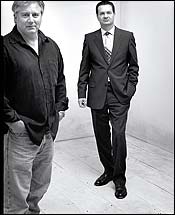
Medical Miracle #6
Problem: Forty-six-year-old Hollywood stuntman. Career-threatening back pain. Traditional spinal fusion not an option. Decides to try risky, experimental disk replacement.
Doctor: Fabien Bitan
Patient: Jeff Gibson
Jeff Gibson is a 46-year-old stuntman who has spent half his life falling from heights in films like RoboCop 3 and Batman Forever, and that’s just when he’s on the clock; in his twenties, he competed in gymnastics and on trampoline, and in his spare time he skydives. “I never looked at any of it as dangerous,” he says. “I just like the freedom up there. Trampoline, I get maybe a second—with skydiving, you get 60 or 70 seconds.” Falling is also his livelihood, of course, and the years have taken their toll. In the early nineties, Gibson slipped a disk lifting something at home, starting down a path of lower-back deterioration that was only made worse by the impact of all those professional and recreational falls. He spent a decade nursing increasing pain from his lower vertebrae until finally it got so bad that his career was in jeopardy. “It would take me twenty seconds to get up if I was bending over,” he recalls. “It wasn’t fun.”
Friends in the business with similar back problems had gone in for traditional spinal fusions, in which the damaged disk is simply taken out and the two neighboring vertebrae locked together. The result is less pain, but at a price. “As soon as you get a fusion, you start deteriorating the disk above and below it and lose motion,” Gibson says. For a stuntman, losing any ability to move or twist his body wasn’t an option. Instead, Gibson put off what seemed like the inevitable until an MRI showed two vertebrae almost next to each other, with nearly all the essential “jelly” in the middle squeezed out. Waiting was no longer an option: If the excess jelly found its way to his spinal cord, Gibson could be in for still more excruciating pain, and perhaps permanent nerve damage.
There was, however, another choice: spinal-disk replacement, a procedure pioneered in Europe in the eighties that was slowly snaking its way through the FDA-approval process here. Gibson, who had found out about the procedure by searching the Internet, tracked down Fabien Bitan, a French-born orthopedic surgeon working at Beth Israel Medical Center who had worked on one of the first disk-replacement cases during his residency in Paris. Bitan was supervising the FDA trials of the surgery in the northeastern United States, and the surgeon confirmed that replacing Gibson’s bad disk with a plastic-and-metal prosthesis might be indicated in his case. Gibson was so determined to have the procedure that he waited in agony for another six months for a new phase of trials that guaranteed he wouldn’t get stuck in a control group. Finally, in August 2001, Bitan ushered Gibson into the OR.
No two disk replacements are ever quite the same: Bitan didn’t know going in how difficult removing Gibson’s decayed disk would be, or how much danger there would be of hitting nearby nerves or the spinal cord. Bitan also couldn’t tell what precise size the new disk should be, so a variety of replacements were on hand. For a perfect fit, Bitan relied not just on his eyes but on real-time X-ray scanning; everyone in the OR was wearing radiation protection. The artificial disk has tiny teeth that lock it between the vertebrae as Bitan delicately hammers it into place; the vertebrae and scar tissue eventually hold the new disk in position. “This is very demanding,” Bitan says. “If the implant is not positioned properly, it might be displaced after just a few days—or, in the long run, the prosthesis might not function properly and there could be chronic back pain.”
Six weeks after surgery, Gibson smashed through a door and landed flat on a marble floor on ‘Third Watch.’ “No problem,” he says.
Gibson noticed a difference right away. “When I woke up I felt great,” he says. “The pain in my stomach”—the disk replacement is done with an incision in the abdomen—“was nothing compared to the pain I’d had in my back for ten years.” Six weeks after the surgery, he took his new disk out for a spin on the set of Third Watch, smashing through a glass door and landing flat onto a marble floor. “No problem,” he says. And if you watched the opening scene of Law & Order on May 11, you saw Gibson fall five stories—on fire.
In October 2004, the FDA approved the procedure, and although it isn’t right for everyone—patients with scoliosis or osteoporosis, for example, aren’t eligible—Gibson is thoroughly satisfied with his equipment upgrade. In addition to his stunts, “I still skydive, scuba dive, and race cars,” Gibson says. “I’ve done everything I can to break this thing, and it hasn’t broken yet.”